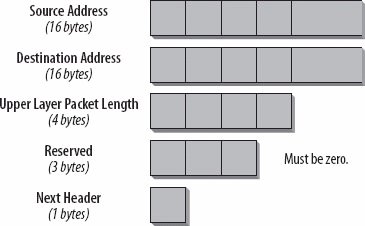Section 9.1. UDPTCP
9.1. UDP/TCPChecksumming is done on different layers. Remember, the IPv6 header does not have a checksum. But a checksum is important on the transport layer to determine packet delivery problems. Other upper-layer protocols may use a checksum, too. All checksum calculations that include the IP address in the calculation must be modified for IPv6 to accommodate the new 128-bit address. Transport protocols such as UDP and TCP attach checksums to their packets. A checksum is generated using a pseudoheader. The TCP and UDP pseudoheader for IPv6 contains fields for Source and Destination address, payload length, and Next Header value (RFC 2460). If the IPv6 packet contains a routing header, the Destination address used in the pseudoheader is the address of the final destination. If the Source or Destination address was changed in transit, the value of the pseudoheader at the destination will not match the value of the initial packet, which causes checksum calculation failure and an error report. Because the IPv6 address is so much longer than the IPv4 address, the IPv6 specification includes a new version of the pseudoheader. The IPv6 pseudoheader specification takes into account that an unknown number of extension headers can be present before the UDP or TCP layer, which is essential when calculating the payload length for the pseudoheader. With IPv4, a checksum in the UDP header was optional. With IPv6, the computation of a checksum is mandatory for UDP. IPv6 nodes that receive a UDP packet with a value of 0 in the checksum field should discard the packet and log the error. The source node calculates and stores the checksum, and the destination node verifies it. Figure 9-1 shows the format of the pseudoheader that is built and used to calculate TCP and UDP checksums. Figure 9-1. Format of the pseudoheader The following list describes each of the fields:
The same algorithm used with IPv4 is used to calculate the checksum with IPv6. The 16-bit checksum is computed over the entire pseudoheader. By including the source and Destination addresses in the checksum calculation, any alteration of the addresses en route would be detected. |